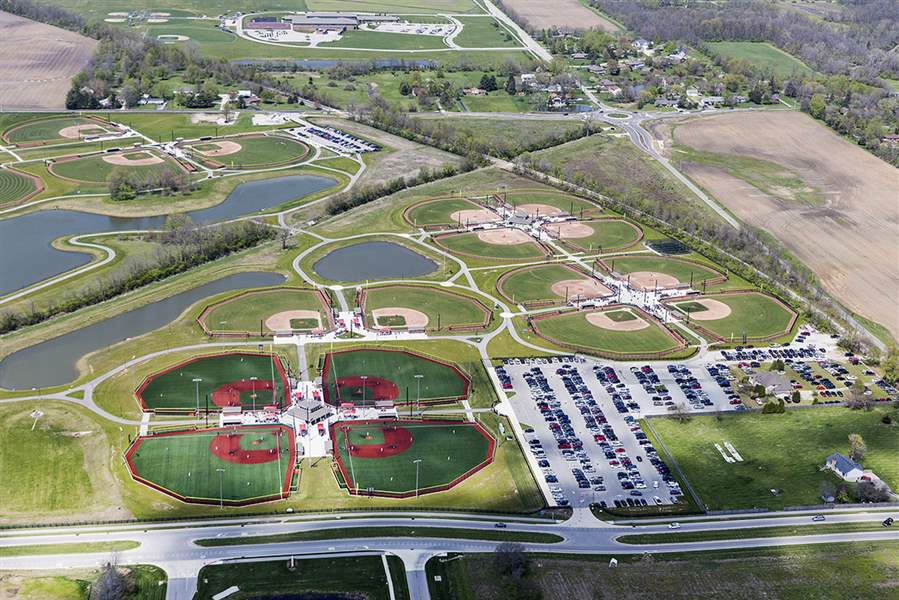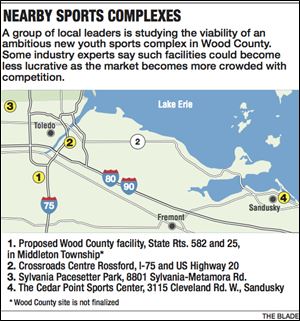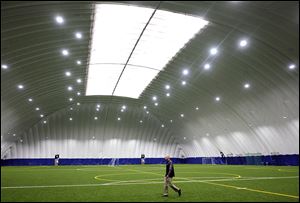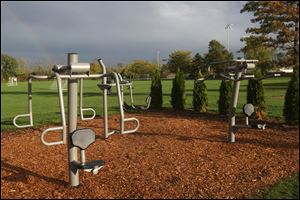
Large athletic facilities come with mixed reviews
11/25/2017
The Grand Park Sports Complex in Westfield, Ind., is an example of what is being proposed for Wood County.
Grandpark.org
Youth sports are big business these days, and local leaders are looking to cash in on the game by building an ambitious — and likely expensive — athletic multiplex in Wood County.
But as such costly endeavors become more common, some industry experts warn the financial payoff for a facility like the one being eyed by officials here could become increasingly diluted.

A map of sports complexes in the surrounding area.
Al Kidd, president and CEO of sports tourism industry trade group National Association of Sports Commissions, said the market has not reached saturation yet, but it could be close.
“If it continues at this pace, two things are going to happen. We will find a tipping point, but the economic growth right now is helping fuel this,” Mr. Kidd said. “It's been going so well for so long that, I'm an optimist by nature, but there has to be a downturn...I can bet my bottom dollar that's going to happen in the next three to five years.”
That’s why local officials have adopted a wait-and-see approach to the project. Maumee, Rossford, and Perrysburg, along with the Wood County Economic Development Commission, have funded a $60,000 feasibility study to see if Wood County can be a viable home to a top-notch youth sports facility, and have said no additional money will be spent until that study comes back.
Rossford Mayor Neil MacKinnon largely summed up the motivation behind the study by pointing to his own experience as a parent of young athletes. He has spent many weekends with his children at sports tournaments, and knows the costs those trips can bring.
“That’s kind of replaced the one week or two-week family vacation,” he said.
Indeed, the National Association of Sports Commissions reported $10.47 billion spent in connection to such sporting events in 2016, a 10 percent increase from 2015, and a 26.1 percent increase from 2012.
The figures suggest the money is there. Perrysburg Mayor Michael Olmstead spoke of cash flowing into the region — including “thousands and thousands of hotel rooms” being booked — when pitching the idea early this month.
But there are reasons for skepticism, too, especially when it comes to whether the true financial impact of such facilities matches the often rosey productions that proceed their construction, said Justin Ross, a professor at the Indiana University with an expertise in local government finance.
“There’s been a lot of efforts to estimate the effects of these things,” he said.“They almost never pass any sort of cost-benefit analysis...They never make their money back.”
Several Perrysburg city councilmen expressed their skepticism around funding a park like this, and Rossford seems to hold a similar view: governments can get the project rolling, but the bulk of the funding needs to be private.
“I would hope it would be privately funded,” Mayor MacKinnon said. “I can almost guarantee the city would not be part of a development.”’
FINDING INSPIRATION

Steve Bach, facility manager at Total Sports Rossford, walks through the 85,000-square-foot dome in Rossford, Ohio. Rossford Mayor Neil MacKinnon says the proposed facility in Wood County could boost the two domes there rather than detract from them.
Mr. Olmstead, the driving force behind the Wood County proposal, has used the Grand Park Sports Complex in Westfield, Ind., as a model. That park houses 31 outdoor multipurpose fields, 26 baseball diamonds, and three indoor multipurpose fields.
Mayor Olmstead hopes a complex in Wood County could be that large, if not bigger, though all parties are waiting on the results of a $60,000 feasibility study. That study will be conducted by Chicago-based firm Johnson Consulting, and should take 12 weeks to complete once the firm begins its work. That has not yet happened, because the four stakeholders have not met to kick off the process.
Grand Park is owned and operated by the city of Westfield, which in 2016 had $60.5 million in debt from the project’s construction. That debt is paid for by a TIF district that surrounds the stadium, William Knox, Grand Park’s director, said.
The park is operationally sound, though he said it is not bringing in huge windfalls for city government. In 2016, the park generated $4.7 million in revenue, with $4.5 million in costs to the city.
Mr. Knox admitted the facility “isn’t driving significant revenue.” But he added the park was never designed to be a revenue generator for city government.
Instead, the park was designed to attract tourists who would spend their money in the city and region. Mr. Knox said two hotels have been built since the park opened in 2013, and four more are coming.
The plans for the park began to form in 2008, with construction beginning in 2011. That allowed the city to take advantage of the nation’s economic recession to get favorable pricing.
“The ground was still not cheap, but it was less expensive then,” he said.
BOOSTING REVENUE
Grand Park is among the largest facilities of its kind in the country, though parks on a smaller scale have popped up in the area.
In Erie County, commissioners approved using half of the hotel tax the county collects to fund sports complexes owned by Cedar Fair and near Cedar Point, which it owns. The bed tax money can only be used to support tourism, Erie County Commissioner Matt Old said.
“This isn’t money our citizens are paying,” he said.
One percent of the four-percent bed tax went to the outdoor sports complex, and another one percent is going toward an upcoming indoor sports complex, which is scheduled to open in 2019.
The outdoor complex includes nine multi-purpose turf fields, four softball fields, eight soccer and lacrosse fields, a championship softball and baseball stadium, and an ADA-accessible community use field. The indoor complex is slated to have 10 hardwood basketball courts, which can be converted to 20 volleyball courts. That should open sometime in 2019.
The county does not get any cut of the park’s profits, but expects the additional tourist traffic will boost tax revenue.
“We want to extend the season of our tourism industry,” Mr. Old said. “We believe that this has increased our number of hotel nights.”
The closest facility that hosts such large youth sorts of tournaments is Pacesetter Park in Sylvania. Mike McMahon, the operations manager for the park, said that Pacesetter primarily hosts events for the local community, which supports the park through a 0.4-mill levy most recently approved by voters in 2012.
The park includes 142 acres of athletic fields that can be converted into varying sizes to fit different sports and age groups. It hosts two very large soccer tournaments each year, one with about 220 teams and another with about 300 teams.
The park opened in 1988, and Mr. McMahon said there was nothing like it when it opened. It drew consistent attention from event organizers wanting to use the facilities for tournaments, and the park has regularly turned them away. Those requests have slowed recently, though.
“The market is oversaturated,” he said. “There’s a lot of youth sports providers out there.”
Still, there are events out there that Pacesetter turns away, and those could end up at this proposed Wood County site. Richard Nachazel, the President of Destination Toledo, said his organization is not directly involved with the Wood County proposal. But he would welcome the proposed complex, which he said would bring plenty of money into the region. He estimates a tournament that brings between 700 and 800 people into the area also brings $600,000 in direct and indirect spending that would likely spread from Wood County over the river into Toledo.
“We would consider it an asset, not competition,” he said.
Mr. MacKinnon said the park could boost the two indoor soccer domes that were recently built at the Crossroads in Rossford, rather than detracting from their business.
“These other facilities could be rented for practice, spillover, or inclement weather,” he said.
ON THE HORIZON

An outdoor workout center is open for use at Pacesetter Park.
Though no firm plans have been announced, two Perrysburg city councilmen said the only proposed location for the Wood County park was at State Rts. 582 and 25, in Middleton Township. That spot is 50 miles from the Sandusky complex, and 163 miles from Grand Park.
Both locations are within the 200 mile radius that Mr. Kidd said helps define how many guests a sports complex can expect from the surrounding area.
“They consider that the drive market,” Mr. Kidd said. “People can drive into a location, participate for the weekend, and drive home. They like it less than that but that’s kind of the maximum radius.”
Facilities have been popping up like weeds, he said, and certain factors have helped foretell success or failure, including population within the drive market, a private/public partnership that tamps down on profit-seeking, the quality of facilities, and an adequate supply of moderately-priced hotels.
Grand Park sees most of its guests from the Great Lakes region, roughly forming a circle that includes Chicago, Louisville, Cleveland, and Detroit. This Wood County site would be within that area.
“We’re always a little concerned about anything that comes into the Midwest,” Mr. Knox said. “I think we’ve done a good job at getting our piece of the industry.”
As the number of these complexes increase, finding proper management becomes harder, Mr. Kidd said. Competition also picks up, diminishing the value of the parks.
“If you’re OK with paying taxes to support it, fine,” Mr. Ross said. “The value of their project will fall if you build yours, and vice versa.”
Contact Zack Lemon at zlemon@theblade.com, 419-724-6282, or on Twitter @zack_lemon.